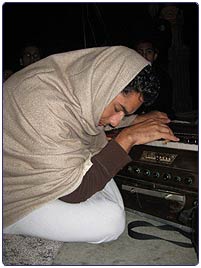Chanters Trade Sleep for Inspiration at 24 Hour Kirtan Festival
By Vineet Chander (Vyenkata Bhatta Dasa) | Sep 04, 2008

Rhythmic recitation of Sanskrit prayers and the ceremonial smashing of camphor-laden coconuts – a ritualistic metaphor for the chasing away of negative energy – inaugurated a festival dedicated to the congregational chanting of Hare Krishna at New Vrindaban, ISKCON’s rural community and retreat center in West Virginia, on Saturday, August 16. The festival, billed as New Vrindaban’s First Annual 24-hour Kirtan Festival, was organized by Gopal Dasa, a second-generation devotee and veteran of the famous Krishna Balarama Kirtan Mandali in Vrindavana, India. Hundreds of devotees and guests poured in to New Vrindavan from all over the United States, and in a few instances from around the world, to be part of the historic gathering.
“The holy name just goes so deep when you give Him the chance to,” opined festival participant Amul Sutaria, a college student from New Jersey. “We all came together to make a sacrifice for the weekend, to forget everything in the past and future and just focus on the holy name. Usually we don’t make so much sacrifice, but this weekend you could see people just go to sleep for like 2 or 3 hours and then get right back into the kirtan.”
The chanting began at 9:00 am on Saturday morning and continued, without interruption, until well after 10:00 am the next day. Various kirtan leaders took different shifts to head off the singing, relieving one another and offering an opportunity to catch up on some rest or, more often, join in the audience and follow along. Parties included the New York Kirtan Party, led by Ananta Govinda Dasa; the Washington D.C. Kirtan Party led by Gauravani Buchwald; and the Alachua Kirtan Party, led by Visvambara Sheth.
For many, the festival’s star attraction was special guest Madhava Dasa. Madhava has recently been gaining recognition as one of ISKCON’s most accomplished young kirtan singers, and has been flown in to lead the chanting at Hare Krishna festivals in Europe, the former Soviet Union, and India. |
| ||||
Notably, he was among the renowned chanters invited to lead kirtans during the installation of the massive Pancha Tattva deities in Mayaupur, India in 2004. At the New Vrindaban festival, Madhava led the chanting during several key shifts, drawing large crowds and enthusiastic responses.
Although the festival was not advertised as a “youth event,” the majority of those who took part in the kirtan were part of ISKCON’s second-generation. Festival organizers, while encouraged by the youth presence, felt that more needed to be done to communicate that the festival was meant for everyone – regardless of age, gender, or background.
“Devotees need to understand that this isn’t an exclsuive ‘kuli [devotee youth] thing’ or whatever,” said New York kirtan leader Ananta Govinda Dasa. “It was never meant to be that. This is for everyone who wants to experience kirtan.”
The Saturday evening kirtan, led by Madhava and supported by a host of mridanga drummers, flute players, and even an electric bass, saw the most participants; the expansive temple room was packed with more than two hundred devotees and weekend guests. The kirtan continued out of the temple building and on procession out to the nearby man-made lake, where a swan boat took deities of Radha Krishna for a moonlit outing.
Long after the faint of heart turned in to their beds, the more adventurous kirtaniyas continued the chanting at Prabhupada’s Palace of Gold, a memorial to Srila Prabhupada and one of New Vrindaban’s most popular attractions. Chanting parties from Washington, D.C. and New York shared the “graveyard shift” and members of the Pandava Sena, an international ISKCON youth group, filled the early morning slot.
Madhava led the final kirtan, with a growing crowd chanting the slow and heartfelt melody as 9:00 am came and passed. By the time he brought the kirtan to its moving climax, the devotees responded with cheers, applause, and – in more than a few cases – tears of joy.
“By the end of the weekend, people I didn’t really know when we started out had become like old friends to me,” Amul said. “It was like we were all united for one goal: to try our hardest to purely chant the holy names.”
The 24 Hour Kirtan Festival coincided with a meeting of the Spiritual Strategic Planning Team (SSPT), a think tank composed of some of ISKCON North America’s most active leaders and preachers. Although the SSPT members spent most of the weekend in meetings and team-building exercises, they also scheduled time to take part in the kirtan as a group, and several SSPT leaders divided their time (and hearts) between the meetings and the chanting.
For one young chanter, who asked to remain anonymous, the fact that the meetings were scheduled at the same time as the kirtan was not an encouraging sign.
“It just shows how they [the SSPT members] are totally out of touch,” he said. “They’re having all these meetings about how to spread Krishna consciousness, but the answer is staring them right in the face. Why don’t they just come here and chant?”
His friend, standing close by, disagreed. “I don’t think that that’s fair. You need both,” he said. “Without those meetings, we wouldn’t have an ISKCON to chant in. But without kirtan, there’d be nothing to have meetings about.”
















